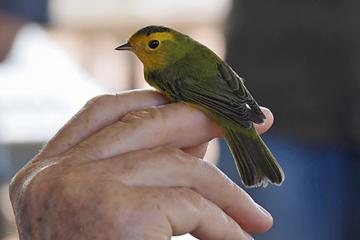Responding to an Ecological Disaster

A visitor gets a close-up moment with a Ladder-backed Woodpecker during migratory bird day at the Mesilla Valley Bosque State Park. (Photo courtesy of Martha Desmond)
Back in 2020, people in New Mexico began to notice something alarming: wild birds were dying — by the hundreds of thousands.
Researchers set out to identify the cause, but also to do something with a longer-term impact: training potential future scientists to understand what was happening. Beginning this year, a collaboration between New Mexico State University (NMSU), the Agricultural Research Service (ARS), and other partner organizations will support the work of about 30 undergraduate and graduate students who are studying the biology of ecological disasters, providing funding as well as access to data and a unique research environment. The project is scheduled to last for four years; the goal is to ensure that when other disasters take place, there will be scientists ready to document and explain them — and hopefully identify some remedies.
Brandon Bestelmeyer, research leader at the ARS Range Management Research unit in Las Cruces, NM, who is the agency contact for the program, said that it illustrates, “all the unexpected ways in which ARS agricultural research can serve many different kinds of scientific progress, including the fact that we can contribute a wide variety of data. We’re not doing research on avian mortality, but we have lots of data that are going to help people solve this problem.”
The Jornada Experimental Range, an ARS-managed research area in southern New Mexico near Las Cruces, was part of the area affected by avian mortality. The site hosts the Long-Term Ecological Research Network, Long-Term Agroecosystem Network, and National Ecological Observatory Network, providing long-term data on weather, dust, vegetation, and animals. These open data can be used by student researchers to understand the causes of avian mortality and, more generally, to become involved in agroecosystems science with the USDA. The project also helps participating students learn about job opportunities with the federal government — including at ARS.

Students, led by Danny Tipton (NMSU Avian Migration student) train their sights on the pathways of migrating birds over Mesilla Valley Bosque State Park in New Mexico. (Photo courtesy of Martha Desmond)
For now, a first step is understanding just what happened in 2020.
It appears there were two main causes. The first was drought that plagued the western United States. Necropsies performed by researchers revealed that, “these birds were severely emaciated, with atrophied flight muscles. They had blood in their stomachs, which indicates that they were starving, they were just in really poor condition,” said Martha Desmond, Regents Professor in the Department of Fishery and Wildlife Sciences at NMSU. Desmond co-leads the project, along with her colleague Tim Wright, Professor of Biology at NMSU.
Coupled with the birds’ condition was, “a freak, extreme weather event,” on September 8, 2020, “that pushed birds during migration down into the desert, some into areas where they just weren’t able to get food,” Desmond concluded. Between the two stressors, many birds simply could not survive.
Biologists believe that we are likely to see similar events in the future, as climate change exacerbates drought and erratic weather.
The solutions are multi-faceted. On one level, the root causes of climate change must be addressed. However, Desmond also stressed that at an immediate, individual level there are many things people can do that make a real difference to birds. Planting native shrubs and grasses helps to feed birds, and keeping cats indoors can also save many avian lives. Desmond also noted that, “so many birds die from window strikes during migration every year — there are decals you can put on your windows, there are blinds you can put down at night.” At a broader level, agricultural management that maintains and restores grasslands can also support bird populations and help them to withstand forces that are difficult to control.

A Wilsons Warbler considers a visitor during migratory bird day at the Mesilla Valley Bosque State Park. (Photo courtesy of Martha Desmond)
Long-term research and new scientists to conduct it are key to identifying and implementing these solutions. The team hopes this program will help birds and engage those who study them.
“Really, the whole idea with this grant is, it’s producing the next generation of leaders in natural resources,” said Desmond. “How do we train those students well, and help them understand what their passion and their dream career is so they can make a difference?” — Kathryn Markham, ARS Office of Communications

